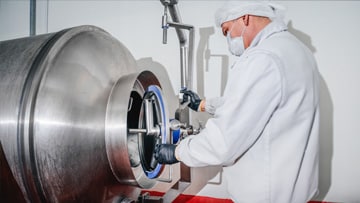Key points
- NIOSH has 10 critical topic areas for nanotechnology research and communication
- These topics areas are a guide to address knowledge gaps, develop strategies, and provide recommendations

The 10 Critical Topic Areas
NIOSH has identified 10 critical topic areas for nanotechnology research and communication. This serves as a guide for NIOSH to address knowledge gaps, develop strategies, and provide recommendations.
Toxicity and Internal Dose
- Investigating and determining the physical and chemical properties such as size, shape, solubility that influence the potential toxicity of nanoparticles.
- Evaluating the short and long-term effects that nanomaterials may have in organ systems and tissues, for example the lungs.
- Determining the biological mechanisms for potential toxic effects.
- Creating and integrating models to assist in assessing possible hazards.
- Determining if a measure other than mass is more appropriate for determining toxicity.
Risk Assessment
- Determining the likelihood that current exposure-response data (human or animal) could be used in identifying and assessing potential occupational hazards.
- Developing a framework for evaluating potential hazards and predicting potential occupational risk of exposure to nanomaterials.
Epidemiology & Surveillance
- Evaluating existing epidemiological workplace studies where nanomaterials are used.
- Identifying knowledge gaps where epidemiological studies could advance understanding of nanomaterials and evaluating the likelihood of conducting new studies.
- Integrating nanotechnology health and safety issues into existing hazard surveillance methods and determining whether additional screening methods are needed.
- Using existing systems to share data and information about nanotechnology.
Engineering Controls and PPE
- Evaluating the effectiveness of engineering controls in reducing occupational exposures to nanoaerosols and developing new controls where needed.
- Evaluating and improving current personal protective equipment.
- Developing recommendations to prevent or limit occupational exposures, for example respirator fit testing.
- Evaluating the suitability of control banding techniques where additional information is needed and evaluating the effectiveness of alternative materials.
Measurement Methods
- Evaluating methods of measuring mass of respirable particles in the air and determining if this measurement can be used to measure nanomaterials.
- Developing and field-testing practical methods to accurately measure airborne nanomaterials in the workplace.
- Developing testing and evaluation systems to compare and validate sampling instruments.
Exposure Assessment
- Determining key factors that influence the production, dispersion, accumulation, and re-entry of nanomaterials into the workplace.
- Assessing possible exposure when nanomaterials are inhaled or settle on the skin.
- Determining how possible exposures differ by work process.
- Determining what happens to nanomaterials once they enter the body.
Fire and Explosion Safety
- Identifying physical and chemical properties that contribute to dustiness, combustibility, flammability, and conductivity of nanomaterials.
- Recommending alternative work practices to eliminate or reduce workplace exposures to nanoparticles.
Recommendations & Guidance
- Using the best available science to make interim recommendations for workplace safety and health practices during the production and use of nanomaterials.
- Evaluating and updating occupational exposure limits for mass-based airborne particles to ensure good continuing precautionary practices.
- Providing guidance and publications to help provide information on the best available science for nanomaterials.
Global Collaborations
- Establishing partnerships and collaborations to allow for identifying and sharing research needs, approaches, and results.
- Developing and disseminating training and educational materials to workers and health and safety professionals.
Applications
- Identifying uses of nanotechnology in occupational safety and health.
- Evaluating and disseminating effective applications to workers and occupational safety and health professionals.
Content Source:
National Institute for Occupational Safety and Health
